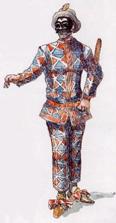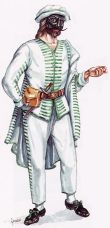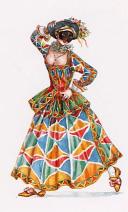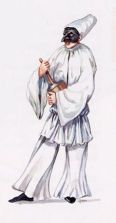|
back to "The
Story of the Mask" |
 |
Commedia
dell'Arte
A form of theatre flourishing in l6th century Italy was the so called court
theatre, popular among the nobility. As the name suggests it was
performed in royal courts and palaces. The first original theatre buildings
emerged at the same time. A form of popular theatre, however, with professional
performers had developed alongside this court theatre. The theatre was known
as commedia dell’arte. Historiography is unable to pinpoint where and when it
began. The first written notes of agreements with theatre companies and actual
performances date from the mid l6th century.
Commedia dell’arte,
however, is expressly an Italian theatre in character and is based on a group
of unchangeable characters, known beforehand. The performances were improvised
and based on a prior agreed or written scenario. The scenario specified the
stage events and actions with entrances and exits. Such a synopsis also included
a list of roles and requisites, and references as to the scenery in the form
of scenes of action. In addition to recognisable costumes and mimicry, the most
important element in each character was a mask centering around the role. To
begin with, the carts accompanying the touring groups and buildings temporarily
taken over served as the performance sites. As commedia dell’arte became increasingly
popular in the l7th century, many groups performed under the protection of a
contract in courts and permanent theatre buildings.
Many different theories seek to explain the origin of commedia dell’arte.
According to one theory, it derived directly from the fabulae Atellana adapted
by the Romans from the Etruscans which were conveyed by wandering performance
groups in the Middle Ages. The fabulae Atellana were comical satirical farces
which, just like commedia dell’arte, were based on a ready selection of
characters with masks. Some of the characters clearly have a similar origin.
Another theory claims that commedia dell’arte originated in Constantinople,
from the influence of theatre groups fleeing from the Turkish conquest. This
theory refutes the idea that commedia dell’arte was a direct development of
the fabulae Atellana, which represented very advanced Roman civilisation.
Furthermore, it seems the tradition of Italian professional theatre running
through the Middle Ages did not exist. One possible explanation for the
similarity between the fabulae Atellana and commedia dell’arte lies in their
origin, which is related to popular carnival tradition and would thus explain
the similarities in both theatre forms.
Commedia dell’arte featured a wide variety of topics
and production forms. The backbone of the programme was comical intrigues which
could also deal with topical events where performances took place. The range
also included fantasy plays and tragedies. The scenarios exploited folktales,
ancient comedies, contemporary texts and historical themes. Commedia dell’arte
characters included Brighella, Pantalone, Pulcinella, Arlecchino, Il Dottore,
LI Inamorato, Il Capitano, Pedrolino, and Caratterista and female figures such
as Columbine and Isabella. The different towns, which these also represented,
especially certain towns in northern Italy, also influenced the development
of the characters. For example, Pantalone was generally a somewhat senile old
dotard from Venice, and Il Dottore a learned university scholar from Bologna.

Use of the mask as a means of character
identification demanded extremely advanced mimicry and often acrobatic skills
of the actors. In addition to improvisation, the cornerstone of an actor’s work
was to use the mask to bring the character to life in a way by replacing facial
expressions with a combination of business language, voice, a mask and linked
to the situation. Commedia dell’arte improvisation was not completely free,
but based on tradition and excerpts of lines learnt from previous performers.
This enabled the performance to progress smoothly whatever the situation.

Commedia dell’arte developed and
gradually changed just as any other art. Its characters took on new features and
variations of old features were created in different places. The number of
female roles increased, even though these didn’t become as permanent and deep
as the male characters. Originally women were given the female roles played by
men
and young boys. This was something new in theatre history. In further boosted
the popularity of the performances, especially when the actresses did not wear
masks. By the beginning of the l7th century, Commedia dell’arte had spread
outside Italy, especially to France and elsewhere in Europe, and underwent its
final rise in Venice in the l8th century under Carlo Gozzi and Carlo Goldoni.
The masks worn in commedia
dell’arte were skilfully made, and comprised fine details. The model for many
of the role masks was similar to corresponding masks worn in the fabulae
Atellana dating from Roman times. The material originally used was based on a
mould of an actor’s facial features, obtained by moistening shaped leather
with an inside layer of felt or material. The features required by each
character were then added to each mould, and in spite of their outward
appearance, the masks fully fitted the face of the wearer. Anyone who has had to
wear a mask for any length of time knows how painful it is to have a shoddy piece of work chaff the face and nasal bridge.
back
on top ^



